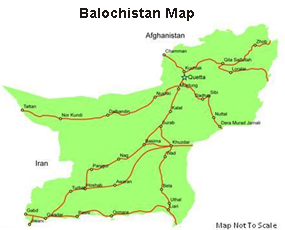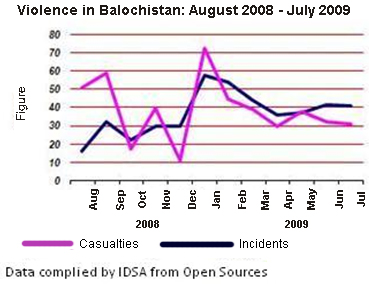- About us
- ABOUT MP-IDSA
- VISION STATEMENT
- CONFERENCE FACILITY
- EXECUTIVE COUNCIL
- Memorandum of Association: Rules and Regulations
- MP-IDSA NEWS
- DIRECTOR GENERAL
- INTERNATIONAL INTERACTIONS
- Fellowship rules
- VISITING FELLOWSHIPS PROGRAMME
- K. SUBRAHMANYAM AWARD
- Deputy Director General
- INTERNSHIP PROGRAMME
- CONTACT US
- Former Presidents
- HUMAN RESOURCES
- JOBS
- Former Directors
- Prevention of Sexual Harassment
- CENTRES
- Events
- Library
- Publications
- Membership
IDSA COMMENT

The Situation in Balochistan
More from the author
The security situation in Balochistan is deteriorating. That explains why Prime Minister Gilani was keen to have Balochistan included in the Sharm el-Sheikh joint Indo-Pakistan statement. This was an effort to deflect attention from the worsening situation in Balochistan. In the last one year, over four hundred attacks on Baloch militants have been carried out in which over four hundred people died. The Baloch insurgency is a low-level insurgency, but it refuses to go away despite the state’s heavy use of force.
This was an effort to deflect attention from the worsening situation in Balochistan. In the last one year, over four hundred attacks on Baloch militants have been carried out in which over four hundred people died. The Baloch insurgency is a low-level insurgency, but it refuses to go away despite the state’s heavy use of force.
In September 2006, the Musharraf regime got veteran Baloch leader Akbar Bugti killed. Violence flared up on the third anniversary of Bugti’s killing. Nawab Akbar Bugti’s killing in 2006 has given a new lease of life to Baloch militancy. Several militant groups are active in Balochistan. These include Baloch Republic Army, Baloch Liberation Army, Balochistan Liberation Front, etc. These are all indigenous groups.
The Baloch militants have generally attacked pipelines, pylons, railway tracks, trains and other government infrastructure. In February 2009, a hitherto unknown militant group called Baloch Liberation United Front kidnapped John Solecki, the Head of UNHCR office in Balochistan, set up to help Afghan refugees staying in the province. They have also begun to target Punjabi teachers and engineers. The government is promising higher pay and allowances to officials posted in Balochistan in order to stop them from leaving the province. This indicates that discontent is simmering in Pakistan’s largest and resource rich province. In August the militants blew up the Sui-Guddu gas pipeline which affected five power stations and took out nearly 1200 MW of power from the national electricity grid. This made the power crisis even more acute in Pakistan which has been facing a power crisis.
Last year, the PPP-led government in Balochistan offered an “apology” to the people of Balochistan for the mistakes committed by the government in the past. The Central government and Baloch groups also entered into a ceasefire in 2008. However, the militants broke the ceasefire since they felt that the talks were not meaningful. Marri, Bugti and Mengal tribes are at the forefront of Baloch insurgency.
Prime Minister Gilani, speaking in the Pakistan National Assembly in April 2009, described the Balochistan situation as one that could destabilise Pakistan. Malik Siraj Akbar, a perceptive analyst of Balochistan affairs, has said in a recent article that an “East Pakistan” like situation is developing in Balochistan.
A parliamentary committee on Balochistan headed by Reza Rabbani has submitted recommendations to the government. The committee has recommended the release of political prisoners, rationalisation of royalties, a revised National Finance Commission award based on provincial size and revenue generated, implementation of all Baloch Assembly resolutions, withdrawal of forces from Sui and all other parts of Balochistan, judicial inquiry into the murder of Akbar Bugti and an All Party Conference on Balochistan. It is yet to be seen whether these recommendations will be accepted. There has been no dearth of committees. Previously, Benazir Bhutto Committee and Mushahid Hussain Committee had given recommendations on Balochistan. Most of these recommendations have not been implemented.
Baloch nationalists continue to feel deprived and alienated. They resent the Punjabi domination and the exploitation of the provincial resources. The presence of the Chinese for the construction of infrastructure projects is also resented. The Chinese have built the strategic Gwadar port in Balochistan which in due course will attract greater Chinese presence because of its strategic location. Several Chinese engineers have been attacked and kidnapped in the past.
The resource-rich Balochistan province has high rates of poverty, unemployment, illiteracy and infant and maternal mortality. According to the Pakistan National Human Development Report 2003, the literacy rate in Balochistan was 36 per cent, the lowest among Pakistan’s provinces. The Social Policy and Development Centre (SPDC) describes the deprivation level in Balochistan as “unspeakable”. 92 per cent of Balochistan’s districts have been classified as “high deprivation” districts, as compared to 50 per cent in Sindh and 29 per cent in Punjab. The Pakistan Integrated Household Survey (2001-02) reveals that 48 per cent of the province’s population is “poor”. Rural poverty in Balochistan increased by 15 per cent between 1999 and 2005. Balochistan has the highest infant and mortality rates in South Asia due to prevailing hunger and malnutrition. Infant mortality rate in Balochistan is 130 deaths per 1000 live births, as compared to Pakistan’s national average of 70. In Balochistan only 25 per cent of the population has access to electricity, as compared to the national average of 75 per cent Punjab has 111 vocational institutes for women while Balochistan has only one. 66 per cent of schools in the province have no proper building while 60 per cent of primary schools have only one qualified teacher. Balochistan has only 9 polytechnics as compared to 340 in Punjab. During Musharraf’s time there was a 62 per cent increase in the number of police stations in Balochistan.
The Baloch insurgency is likely to continue to simmer for a long time. However, the insurgency does not have the critical mass to challenge the all powerful state. At the same time the state will not be able to stamp out the insurgency entirely.
Related Publications